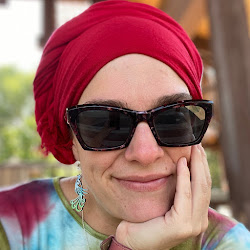Secondly, here's a post I put up over on Jewsbychoice.org today. I guess I'm the Torah-girl in residence of sorts. Anyhow, give it a read, folks.
This week’s Torah portion is T’rumah, which means gift or offering. This is the portion of Exodus where the instructions are given for the Tabernacle (Mishkan) and all Israelites whose hearts so moved them are instructed to round up the supplies for the construction of the structure, a "sanctuary" for G-d. And within this Tabernacle, G-d will dwell among the Israelites.
I wanted to write, just briefly, to take note of that last sentence. The portion says that the purpose of the construction of the Mishkan is so that G-d may dwell among the Israelites, and of course my initial worry about this and the portion as it is composed, is the idea of idolatry. The purpose, perhaps, of the construction of this structure, to be with the Israelites, is so that the feeling of G-d at Sinai can be with the Jews always, as we know that moments and instances of intensity are fleeting. What if we forget that feeling? The Tabernacle, thus, is a physical site to "represent the presence of G-d" in the midst of the community. It is to become a "sacred space." (These quoted words come from my reading of Etz Chayim, the Conservative chumash w/commentary.) My concern, of course, comes from the idea that an object can represent G-d, or at least do so in the eyes of the community. How does a community draw lines? How does a community — a new community like the Israelites — define the sacred space without allowing the sacred space to become that which is worshiped?
We see in many religions that symbols become almost worshiped items — figures of saints or holy places. The cross itself has become a worshiped symbol among Christian believers. I know some might take offense to that idea, but that is my opinion of the object. Many have said to me that Jews wearing the magen David is quite the same thing, taking a symbol and placing it forth as an idol of sorts. Of course, for those who know the story of the star of David, the idea that it is symbolic as an idol is preposterous. It is by no means a necessarily "holy" symbol so much as it is a representative symbol — but most definitely not worshiped.
But for believers — of all faiths — the struggle with the unknown in a place where everything is physical, immediate, and evident is difficult. You can see the computer in front of you, and you know precisely what it is. But for the religious, you do not know of G-d or the afterlife or anything beyond the immediately physical realm. Creating idols and symbols to worship makes sense out of that which we do not understand.
But the sages have said that the importance of sacred space was to remind us that G-d does not exist exclusively in the heavens, "remote from humanity" — or rather, that G-d has not forsaken us. Exodus 25:8, which says the structure is that so G-d may "dwell among them," is meant to serve as this reminder. The Tabernacle as such is not per se a sacred space of G-d’s dwelling, but rather a physical reminder of a non-physical presence.
Of course, on a related note, we know that with the destruction of the temples came Rabbinic Judaism and the permeation of the synagogue as the house of meeting for Jews. The synagogue (or shul or temple) serves as the modern-day Tabernacle with some more social features, perhaps than the former. The synagogue has many holy objects that remind us of the presence of G-d, and perhaps it can be said that the synagogue serves so much as a physical reminder of G-d’s presence, dwelling among us in modern times.
So my question, amid this little Torah spiel, to you all is to express what purpose the synagogue serves for you. To you, is it a place for G-d to "dwell among" us? Is it a house of prayer? Is it merely a structure within which we meet friends and family to represent like ideals? Is it, indeed, a sacred space that exists as a reminder of those feelings from the foot of Sinai?
Be well, friends. It’s time for me to go dig myself out of the snow!






